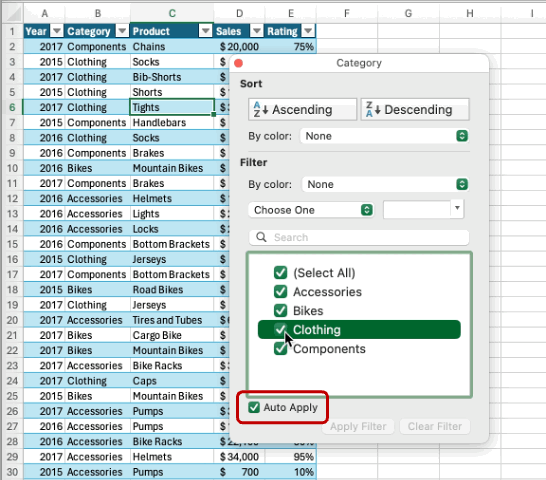Excel for Mac: Mac Only – Auto Apply for Filters
7 June 2024
This week in our series about Microsoft Excel for Mac, we show you some small differences in the way that filters work, why it’s that way, and why it might be important to you.
The Filter dialog is a fundamental part of Excel and it’s used in numerous places – on ranges, tables / Tables and PivotTables. Knowing how to filter your data is key, so keep reading to understand how filters work in Excel for Mac.
Auto Apply
On Mac, you have an option for filter selections to take effect immediately or after you’ve finished making selections. The default setting is for the filter to be updated immediately as you select values in the filter. Unlike Excel for Windows, you don’t need to press OK to apply the filter. Notice in our example below, the table behind the filter dialog becomes filtered immediately upon changing the selections. If you disable the ‘Auto Apply’ setting, then you’ll need to press ‘Apply Filter’ when you’re ready.

When to Disable Auto Apply
In most cases, ‘Auto Apply’ won’t cause you any problem, but there are two [2] reasons you may wish to disable it:
- Personal preference: you might find it distracting to see the filter applied as you make selections in the Filter dialog. There’s no impact to the final result of your filter choices, so it’s a personal preference. If you don’t like seeing changes applied immediately, then just disable the option
- Performance: if you have a large amount of data to be filtered, you may notice a delay after each selection. Excel may seem unresponsive for a short time. If this happens, you can disable ‘Auto Apply’ and it should avoid any slowdowns while you’re making your filter selections.
You should note that your choice for ‘Auto Apply’ will take effect for all workbooks and will remain in effect even after you quit and restart Excel. You can change it at any time by opening the Filter dialog.
We hope you found this topic helpful. Check back for more details about Excel for Mac and how it’s different to Excel for Windows.

